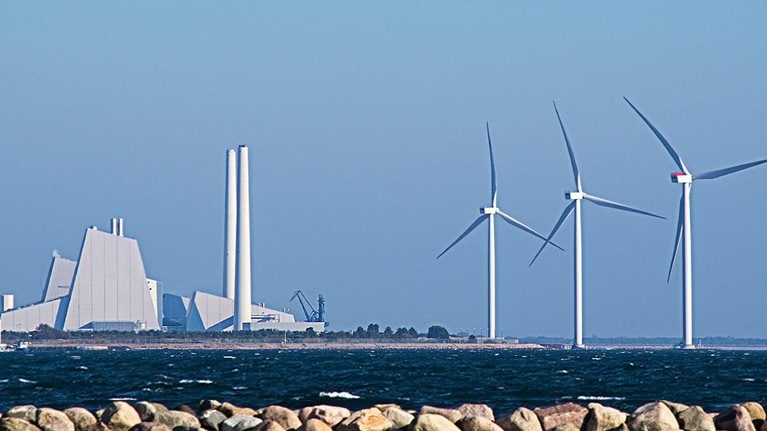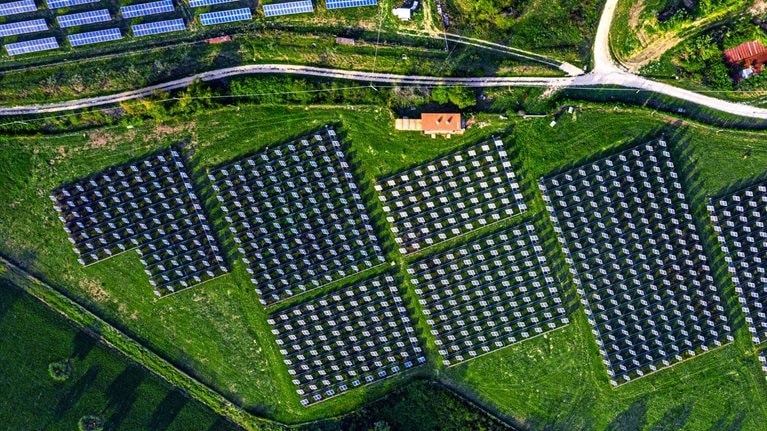The energy transition is underway. Corporations and policymakers are embarking on ambitious decarbonization journeys to reduce dependence on fossil fuels. Renewable natural gas (RNG) emerges as an alternative fuel that could contribute to substantial emissions reductions across multiple industries.
At present, fossil natural gas—which comprises 95 percent methane, 5 percent ethane, and trace amounts of other hydrocarbons—is the second largest source of primary energy in the United States, responsible for 33 percent of the country’s energy consumption in 2021.1 And in the last decade, natural gas consumption has grown by approximately 2 percent per year.2 As natural gas plays a significant role across sectors in the US energy system—including building and industrial heating, transportation, chemicals, and power generation—much infrastructure (such as wells, pipelines, power plants, and liquid natural gas [LNG] export terminals) has been built to extract, transport, and combust natural gas.
RNG is a purified form of waste-derived biogas generated from anaerobic processes and then upgraded to pipeline-quality gas. It is virtually indistinguishable from fossil natural gas (both are more than 95 percent methane).3 RNG has the potential to decarbonize a portion of the emissions across many sectors and can be a like-for-like (in other words, a “drop-in”) replacement for fossil natural gas—meaning that end users do not have to modify engines, distribution systems, or other equipment when switching.
Depending on the type of waste (feedstock) used to produce RNG, the associated greenhouse gas (GHG) reduction ranges between 50 percent (emissions intensity of approximately 50 grams CO2 equivalent per megajoule [gCO2e/MJ]) and 300 percent (emissions intensity could drop lower than approximately 300 gCO2e/MJ) compared to fossil natural gas (90 to 100 gCO2e/MJ). This calculation will vary based on feedstock as well as the calculated baseline emissions for natural gas used for comparison (see sidebar, “RNG can be produced from a variety of sources—with varying costs, availability, and carbon intensity").4 This characteristic, combined with RNG’s ability to be used in existing gas infrastructure without infrastructure modification, points to its physical viability as an alternative to fossil natural gas.
However, because RNG is feedstock limited and is not always economically viable, it is not a silver bullet for decarbonization. Currently, RNG supply represents less than 1 percent of natural gas supply in the United States and, even if supply were built out to utilize all potential feedstock, RNG would represent about 5 to 20 percent of current natural gas demand.5
Despite RNG’s supply limitations, it can become an important part of a portfolio of solutions to achieve deep decarbonization, particularly in the near term, as other low-carbon molecules such as hydrogen are still in the early stages of commercial scale-up. Therefore, scaling up RNG—and determining which end-use markets can derive the most value from it—matters in the energy transition.
This article explores the RNG landscape, including the regulatory environment, the prospects and challenges for developers, and potential unlocks to capture value and realize RNG as a sustainable energy source.
The RNG market and evolving regulations
Policy addresses three areas of the RNG market: first, which end uses consume RNG; second, the calculation of RNG’s carbon intensity (and therefore its value); and third, where RNG physically comes from and to where it can be sent.
End uses
Most RNG goes toward compressed natural gas (CNG) vehicles due to policy incentives, including the federal renewable identification number (RIN) scheme and the Low Carbon Fuel Standard (LCFS) available in British Columbia, California, Oregon, and Washington.6 Based on our analysis, these policies can provide incentives up to 20 times the value of natural gas.
The CNG market is small—transport represents less than 1 percent of US natural gas demand. The CNG market in CA is already saturated with RNG and will continue to be saturated as growth in EVs outpaces growth in CNG.7 Other sectors’ uptake of RNG will largely hinge on policy, including:
- Buildings (26 percent of natural gas [NG] consumption). Several states—including California, Illinois, and Minnesota—have passed policies that facilitate gas utilities blending RNG into their systems.8
- Power generation (38 percent of NG consumption). RNG could theoretically earn value in power generation in some states through Renewable Portfolio Standards, though Renewable Energy Certificate (REC) pricing is currently insufficient to spur the RNG market in the power sector.9 Alternately, the Environmental Protection Agency’s (EPA) December 2022 proposed rule introduced a potentially more lucrative opportunity to generate RINs via biogas-to-power for electrified transport, but relevant policies were not implemented in the EPA’s final 2023 Renewable Fuel Standards.10
- Industry (32 percent of NG consumption). The United States does not have policies promoting the use of RNG in industry. Industrial demand for RNG is instead driven by companies meeting voluntary climate targets.11
Carbon intensity
Under some policy mechanisms, the carbon intensity (CI) of RNG is critical to its value. Therefore, CI accounting policy will influence the relative value of RNG production pathways and which types of RNG go to which end markets.
For example, in California’s LCFS policy today, varying assumptions related to avoided emissions during RNG production result in materially different carbon intensities and associated LCFS credit values across production pathways.12 Agriculture manure is assumed to emit methane in a baseline scenario; as a result, RNG produced by processing that manure is calculated to have a very low CI due to the avoided methane emissions. By contrast, landfills typically have a cap that captures the methane before it is emitted and a limited amount of methane is released to the atmosphere in a baseline scenario—therefore, the CI calculation for RNG from landfills assumes a smaller avoided methane emission, leading to a higher CI (Exhibit 1).

Federal RINs, on the other hand, are calculated on a volumetric basis where each unit of RNG derived from organic waste will yield a RIN, regardless of CI.
As a result of varying incentives for carbon intensity, almost all dairy RNG today flows to the CNG transportation markets in California and states with similar incentive programs (for example, Oregon and Washington). Pathways calculated to have higher CI—such as landfill RNG—are increasingly selling into markets that do not provide financial incentives based on the CI for RNG. However, regulators like the California Air Resources Board are currently considering baseline methane emission calculations.13
Policy impacts from where, and to whom, RNG can be sold
The LCFS book-and-claim system means developers do not have to physically deliver RNG to the end consumer, but rather “book” every unit of gas injected into the grid and “claim” consumption when the end user consumes a unit of gas. This means any RNG developer with access to a North American pipeline might sell to a CNG fleet in California and earn LCFS credit value.
Policies impact the way in which end use sectors consume RNG, how much each sector is paying for each RNG production pathway, and from where they buy their RNG. Generally, current policy direction creates tailwinds for the industry.
Tailwinds are strong, but developers face real challenges
Recent regulatory changes such as the Inflation Reduction Act’s (IRA) policy guidelines, the EPA’s e-RIN proposal laid out in the 2023 to 2025 Federal Renewable Fuel Standard (RFS), and state blending targets could support an expansion in RNG demand.14 In addition, the IRA could provide tailwinds for RNG development due to a 30 percent biogas Investment Tax Credit (ITC) through 2025, as well as carbon capture and hydrogen production tax credits that make both blue hydrogen and broader clean fuels more attractive.15
RNG capacity in the United States has grown fourfold since 2015, with landfill and agriculture manure projects driving 90 percent of US supply.16 Investors and corporates are deploying significant capital into RNG.
Despite the emerging tailwinds, this rapid scale-up and demand shift creates complications for RNG developers:
- Current CNG markets are at risk of saturation. The market has historically been the most attractive for RNG; however, growth in US demand for CNG is projected to slow post 2030 as improvements in electric vehicle (EV) battery technology lead to electrification outcompeting CNG in medium-duty and heavy-duty fleets.17 In addition, the high volatility of LCFS and RIN prices has developers looking for longer-term fixed price agreements to limit their market price exposure. As the market shifts from CNG, developers seek to identify high-value and longer-term off-takers.
- Cost to produce is increasing. Supply chain and financing costs are driving up project costs and extending development timelines. Meanwhile, project developers are trying to rapidly scale up their execution capabilities, often aiming to build more than ten projects per year (up from approximately three per year), to meet growing demand. Few developers yet have the scale, experience, or bandwidth to implement capital and operational best practices that are needed to drive down project costs.
- Lowest-cost RNG feedstock sources are scarcer. Most US RNG production today comes from large landfills and dairy farms (with more than 5,000 dairy cows) that can deploy larger-scale digesters and hence operate at lower per unit cost than smaller facilities. There is, however, still an untapped long-tail supply of farms (such as swine, chicken, and smaller dairy farms) that are harder to commercialize than large farms, and landfills that are generating biogas today but have not yet upgraded to RNG. While supply potential remains, alternate sources of supply will be harder to develop cost effectively.
Would you like to learn more about our Electric Power & Natural Gas Practice?
Potential unlocks for RNG developers
To navigate emerging challenges and take steps to capture value, RNG developers who act now could choose to do so in several ways.
Secure off-takers looking to monetize low-CI products
As the CNG market saturates and the regulatory environment continues to evolve, developers may seek to diversify customers—such as from CNG fleet owners to a mix of utilities, hydrogen producers, and potentially electric vehicle OEMs—and to diversify exposure to credit schemes. For instance, developers could diversify their current revenue streams from ones reliant on LCFS and RINs to include hydrogen production tax credits, or offtake contracts with utilities that have blending mandates.
There are three primary market opportunities that developers can evaluate, including:
- Collaborating with utilities to decarbonize heating, while maintaining customer affordability. Utilities have regulatory requirements—including those to procure RNG in some states—while maintaining low rates for their customers. Therefore, many utilities will seek to procure RNG on a least-cost per million British thermal units (MMBTU) basis. RNG developers (particularly those with lower cost and higher CI, such as developers producing RNG from landfills) could offer utilities least-cost per MMBTU gas that meets their regulatory requirements while minimizing rate impacts. These utility priorities may shift over time and will likely vary by state, as gas utilities and their regulators evaluate and value decarbonization levers.
- Watching regulatory signposts to monitor e-RINs as a potential opportunity. LCFS has approved several biogas-to-power pathways for transportation, and the EPA’s December 2022 proposed rule would have created incentives for RNG-to-power projects nationally. However, the rule was not implemented in 2023.18 If an e-RINs rule is implemented in line with the December 2022 EPA proposed rule, power for EV charging―via offtake contracts with passenger-vehicle OEMs―could be an end market for RNG producers to explore.
- Fueling low-carbon hydrogen production in existing plants. In the United States, most hydrogen is carbon-intensive “grey” hydrogen, produced via steam methane reformation of fossil natural gas at approximately $1 per kilogram of hydrogen.19 The IRA incentivizes low-CI hydrogen production. For example, retrofitting existing hydrogen production plants with carbon capture can produce “blue” hydrogen, worth up to $1 per kilogram of incentive value for ten years of project life from the IRA. Pending policy guidance, adding even small blends of carbon-negative RNG—as low as 7 to 10 percent—can qualify for IRA incentives of $3 per kilogram, equating to around $200 per MMBTU for RNG (Exhibit 2). Thus, the combination of negative CI RNG and carbon capture and sequestration (CCS) could potentially be an economically attractive pathway for hydrogen producers.

Accelerate development at scale
Supply will need to triple in the next decade to meet expected demand and decarbonization goals. To scale up supply, RNG project developers will need to build capabilities in capital project development. These include executing several projects in parallel on time and on budget; managing EPC contractors; securing outside financing including debt and federal and local incentives; and overseeing and optimizing ongoing operations across an at-scale project footprint.
Scale itself will create value. As developers scale, they could realize lower cost of capital by grouping multiple projects to capture tax equity via the IRA’s ITC (through 2025). Additionally, larger developers could contract at scale with major customers, like fertilizer companies or gas utilities, thus securing long-term, more stable contracts.
Commercialize the harder-to-capture potential
Agriculture manure and landfill biogas are the largest sources of RNG feedstock. Some RNG developers have publicly announced partnerships with large agricultural players, and landfill biogas feedstock is a well-established source of RNG.20
Nonetheless, smaller-scale farms and landfills with feedstock access remain untapped— currently most cannot justify the high fixed cost of a large-scale digester. For instance, about 90 million to 100 million MMBTU of RNG potential could be obtained from small landfills, although only about 1 to 2 percent of that potential is being used today for RNG production.21
To access these untapped smaller farms and landfills, a developer could:
- reduce overall digester costs using modular “plug and play” design technology solutions instead of tailored design solutions
- centralize operational support and maintenance for clusters of facilities
- pool manure from closely located farms to enable the build of single, large-scale digesters instead of individual smaller ones
- combine varying types of feedstocks (for example, agriculture manure and sorted food waste) to increase scale and unlock cost efficiencies
RNG has significant capacity to grow in the United States, both on the demand and supply side. Developers are starting to aggressively pursue the opportunities that arise. They could take advantage of new offtake sectors, the benefits of development at scale, and the as-yet untapped sources of supply to unleash RNG’s full potential to be a sustainable energy source. This could reduce GHG emissions and propel the transition toward a greener and more resilient future.




